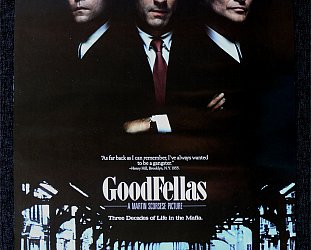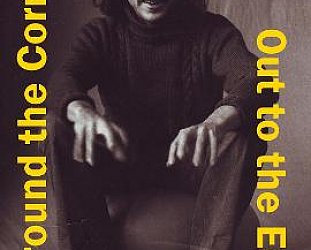Graham Reid | | 2 min read
Diego: Nun c'e pirduni (from the album Omerta, Onuri e Sungu; La Musica della Mafia Vol 2)

Most tourists to Italy tend to visit the north for very good reason: up there are the big boxes to tick off: Renaissance Florence; the canals and contemporary art of Venice; the grandeur that was Rome; the medievalism of Siena and so on.
The north is where the art and culture resides (at least in the tourist's imagination and seen through rose-tinted glasses), and fewer people head south of Naples, that extraordinary city which I often describe to friends as the Bangkok of Italy for its flashes of beauty crammed between the chaos of traffic and streetlife, and seething political and criminal undercurrents.
Further south, with the exception of places such as Sorrento, and Trani on the east coast, southern Italy can be grim, industrial, unfriendly and poor -- as readers of the title story of my travel book The Idiot Boy Who Flew will know.
Yes, there are are fascinating things to see, but frankly cities like sprawling Taranto and Lecce (despite the mad architecture) might not seem worth the effort.
Southern Italy is also notoriously corrupt and Naples is home to the Camorra, the Italian equivalent to the Mafia of Sicily. These are the people who control (as Tony Soprano does) "waste management" -- which explains why in early '09 toxic waste was found dumped at sea.
The Camorra has its tentacles into everything and this film -- a relentlessly bleak, fictionalised adaption of journalist Roberto Saviano's groundbreaking expose of Camorra activites of the same name (the title a play on Sodom and Gomorrah, the biblical cities of the damned and doomed) -- is unflinching in exposing it for its lack of glamour.
Gomorrah is presented by Martin Scorsese, but Scorsese's gangster movies are very different: above the brutality in films like Goodfellas and Casino there is the allure of the fancy clothes, money, the lifestyle of entitlement and camaraderie of "the family" (until you make a mistake).
Gomorrah is nothing like that: the five stories here explore the routine of a mild mannered, small time guy who is a bagman paying out loyalists whose family members are behind bars; two deluded gun-obsessed young hoods hoping to make the big time; corruption within the garment industry and the sweat shops associated with it; a boy who becomes involved with drug dealers and gang rivalry; and a young man who has a pang of conscience about the dumping of toxic chemicals.
Their stories briefly overlap in some places, but the effect is to give a broad picture of just how wide and deep the Camorra have penetrated life in Naples and nearby Caserta.
Director Garrone also keeps his subjects at a distance: we may feel some small pang of sympathy for a couple (the smalltime pay-out man, the boy whose friend joins a breakaway gang so they are now enemies) but mostly there is a detachment as we see these people going about their illegal, menacing and sometimes bloody business.
They deliver death with equally casual indifference too.
 The location is compelling and bleak: the battleship-like apartment complex must have been an architect's visionary conceit when it was first constructed but now with areas burned out, bits falling off, drug dealers and their lookouts on every level and barren concrete spaces, the whole place feels like the jungle of the doomed.
The location is compelling and bleak: the battleship-like apartment complex must have been an architect's visionary conceit when it was first constructed but now with areas burned out, bits falling off, drug dealers and their lookouts on every level and barren concrete spaces, the whole place feels like the jungle of the doomed.
Such open spaces as we see are garbage-strewn, broken, abandoned, ugly. I saw a lot of places like them as I made my way down to Copertino in the heel of the boot for that story in my book.
Gomorah won't be everyone's idea of a gangster flick, and it certainly doesn't conform the Scorsese model, and in fact makes Marty's shiny work look like costume dramas.
This is about shitty people doing shitty things in a shitty world. Sometimes getting away with it, sometimes not.
It looks like hell on Earth -- and yet you can't look away.
Exceptional.







Martin - Jan 23, 2010
Gomorrah sits as a superb movie, initially for it's sheer stunning effect and ability to absorb you, but in a manner that transfixes you as you feel like you went the whole twelve rounds. The movie makes you dislike these Camorra beyond any fantasy that may exist about so called organised crime. The two ultra gangster youths whose storyline eventually gives us that sickening final scene are anything but organised. Their decision to go it alone and turning down offers to join the club was more than a bad idea. When they test their new stolen machine guns in a riveting scene on a harbours edge, not satisfied with emptying the magazines, one aims wildly a bazooka shell at a ferry sized moored boat and he and his two-bob mate are just plain stoked, as the boat is incinerated. The very lanky young goon particularly stands out and that too exhuberant look on his face at all times is perfectly believable. Hardly anyone is likeable, and we sure get the picture. I would think that the cold code of cruelty throughout is due partly to their recruitment in their early teens. Highly entertaining with a rogue gallery expertly assembled and subsequently executed.
Savepost a comment